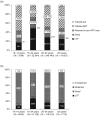High attrition before and after ART initiation among youth (15-24 years of age) enrolled in HIV care
- PMID: 24076661
- PMCID: PMC4517438
- DOI: 10.1097/QAD.0000000000000054
High attrition before and after ART initiation among youth (15-24 years of age) enrolled in HIV care
Abstract
Objectives: To compare pre and post-ART attrition between youth (15-24 years) and other patients in HIV care, and to investigate factors associated with attrition among youth.
Design: Cohort study utilizing routinely collected patient-level data from 160 HIV clinics in Kenya, Mozambique, Tanzania, and Rwanda.
Methods: Patients at least 10 years of age enrolling in HIV care between 01/05 and 09/10 were included. Attrition (loss to follow-up or death 1 year after enrollment or ART initiation) was compared between youth and other patients using multivariate competing risk (pre-ART) and traditional (post-ART) Cox proportional hazards methods accounting for within-clinic correlation. Among youth, patient-level and clinic-level factors associated with attrition were similarly assessed.
Results: A total of 312,335 patients at least 10 years of age enrolled in HIV care; 147,936 (47%) initiated ART, 17% enrolling in care and 10% initiating ART were youth. Attrition before and after ART initiation was substantially higher among youth compared with other age groups. Among youth, nonpregnant women experienced lower pre-ART attrition than men [sub-division hazard ratio = 0.90, 95% confidence interval (CI): 0.86-0.94], while both pregnant [adjusted hazard ratio (AHR) = 0.85, 95% CI: 0.74-0.97] and nonpregnant (AHR = 0.79, 95% CI: 0.73-0.86) female youth experienced lower post-ART attrition than men. Youth attending clinics providing sexual and reproductive health services including condoms (AHR = 0.47, 95% CI: 0.32-0.70) and clinics offering adolescent support groups (AHR = 0.73, 95% CI: 0.52-1.0) experienced significantly lower attrition after ART initiation.
Conclusion: Youth experienced substantially higher attrition before and after ART initiation compared with younger adolescents and older adults. Adolescent-friendly services were associated with reduced attrition among youth, particularly after ART initiation.
Conflict of interest statement
Figures
References
-
- UNICEF. Opportunity in crisis: preventing HIV from early adolescence to young adulthood. New York: United Nations; 2011.
-
- United Nations. World Population Prospects: the 2008 Revision, Highlights. New York: United Nations; 2009.
-
- UNAIDS, editor. UNAIDS. World AIDS day report 2012. Geneva: UNAIDS; 2012.
-
- McNairy ML, El-Sadr WM. The HIV care continuum: no partial credit given. AIDS. 2012;26:1735–1738. - PubMed
Publication types
MeSH terms
Substances
Grants and funding
LinkOut - more resources
Full Text Sources
Other Literature Sources
Medical


